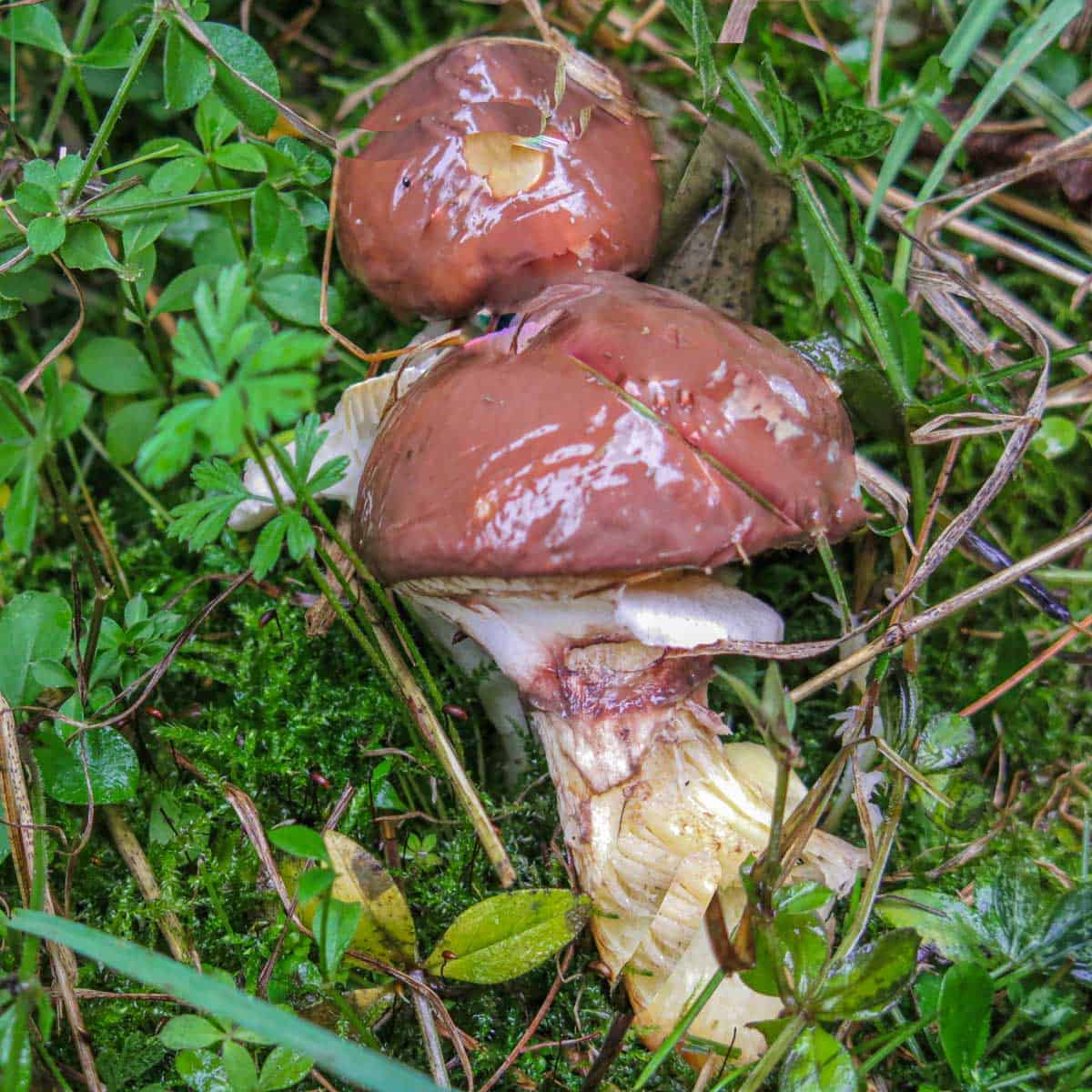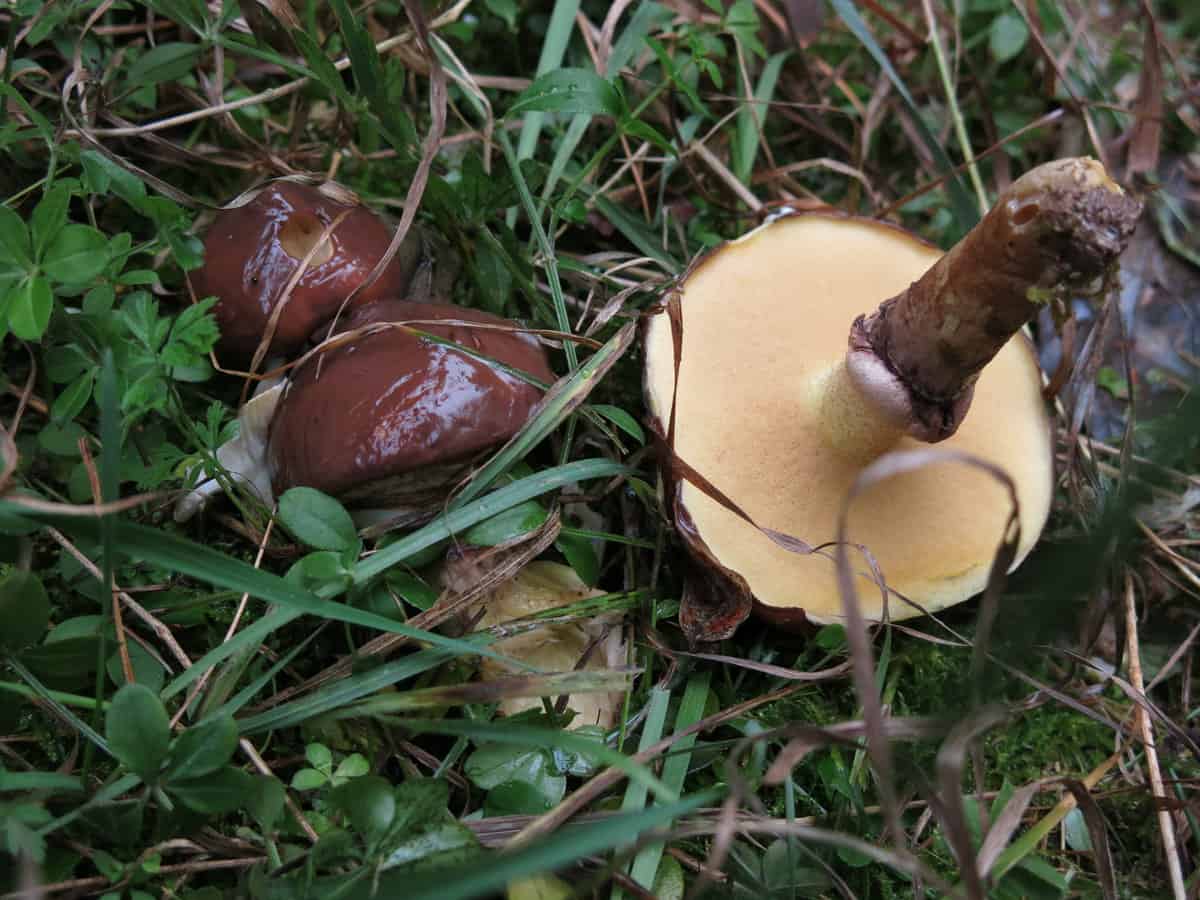To me, Suillus luteus, is the "original" slippery jack. Original in that it really possesses all the characteristics associated with suillus species: slimy, sticky cap, and the presence of a veil covering the gills when young, which eventually leaves a ring around the stem.
Even though I had read about it for a while, it did take me at least two years to find my first ones of this particular species. I had to go to the pine forests and watch the Russians pick them to know truly what they were.
I had seen other slippery jacks, such as chickenfat boletes, but this one was the big daddy, the one and only Suillus luteus, beloved by Eastern European mushroom hunters around the world. Chicken fat boletes are similar in that their caps can be a bit moist, but S. luteus is the absolute definition of slimy, in the surface of it’s cap at least.
Most of the time I see field guides simply label this slippery jack as “edible” or sometimes “edible with caution”. The caution part comes in because it must be peeled before eating, unlike the chickenfat bolete.
If the mushroom’s slimy cap covering is not peeled off and removed, it can cause gastric upset, although this has never happened to me.
Habitat
These grow in the late fall in Minnesota from my experience, around the same time as other slippery jacks. Look to coniferous forests. When I am looking for these I usually notice other slippery jacks as well that are very easy to see, chicken fat boletes, for example.
The forest I most frequently see them around has a large number of eastern white, and Norway pine. When large and mature these will be even more intimidating in the kitchen, so you need to find fresh, young specimens.
You will need to know exact trees they grow around to find tiny buttons, but once you know a spot they grow, keep checking it after rainstorms when they start start to fruit and you will find small, perfect keepers. They are really at their finest when the thin veil covering the gills is not yet broken.
Cooking
These can be a little tricky. If you don’t peel the caps and stems, inspect them for debris, and use them with due haste: you will probably hate them. The cap’s covering and sometimes it’s remnants on the stem are not good to eat, they must be peeled off, as one might the skin of a carrot.
When peeled properly, you will be left with nice, firm mushrooms, as long as what you picked was young and pristine. These are not really mushrooms that I will sit down and scarf a plate of by themselves, they would much rather be utilized in some sort of preparation to add background interest, such as in a chicken soup, or in a sauce to compliment meat.
Preserving
As far as preserving them goes, drying is my first choice. After reconstituting, the mushrooms will still show a bit of their slipperyness, but it will not be as squishy and full of water as fresh specimens are. Another reason to dry them too is that slippery jacks, like most boletes, have a shorter shelf life than many other mushrooms.
In addition, when dried, they transform and take on an aroma that is very different than when fresh, it's rich and woodsy, like a bolete, but different. Dried Slippery jacks tend to develop an immediately recognizable scent that is pretty strong- I would describe it as a bit of an “acidic” tone to the nose, S. Luteus is a perfect example, as is the chicken fat bolete.
Recipes
Recipes I've made especially for slippery jacks, or where they can be easily substituted. The escargot and homemade ricotta cheese with slippery jacks are my favorite with these.



Jacqui
This year I hit Suillus paydirt by being in the right place at the right time.
My favourite preparation was hard fried to dry them out and carmelise them a bit then cooked together with toasted buckwheat groats (kasha), then topped with crispy fried onions. I think this is a true an eastern European dish as you can get. They were, of course, also good in the barley soup.
And then, because I still had way too many mushrooms, I dried about a kg, which filled my house with a toasty mushroom aroma with over/undertones of chocolate. Have you noticed that when drying slippery jacks? I really understand why the coffee complements them so well. But have you tried cocoa?
Jacqui
oops. Just noticed some older comments where, yes, you did notice the chocolate aroma. What about adding powdered slippery jack to a praliné?
Gregory White
My wife and I just moved to Nova Scotia and discovered a few days ago that the back part of our yard is covered in slippery jacks. We have too many to eat and we just bought a dehydrator so we'll dry some. So you wouldn't suggest peeling the caps before drying? Just put them in the dehydrator slime and all?
Alan Bergo
Peel them if you can, certainly.
Claire
I live in suburban Seattle, and here we have Fat Jacks (Suillus ponderosus). I find them at a local park and dehydrate them for risotto. The smell they create as they are drying is heavenly...I can only describe as mushroomy...as I do not have the nose of a sommelier. They look horrific....really dark brown. But just fantastic flavor.
Rachael
I’m drying my slippery jacks, peeled and cut into quarters, in a slow oven for3 hours. Still a bit moist, softish flesh.
I’m leaving them in there now that I’ve turned off the oven. But should I freeze them if they are not fully ‘paper, dry?
Alan Bergo
Hi Rachael, I wouldn't freeze them, I would dry them completely, until cracker dry, and store in a cool dark place. Technically you could freeze them if they aren't fully dry, but I don't really see the point in that. Alan.
NancyLee
Hi Alan,
Always find your writing interesting and informative.
I just harvested a batch of boletes (non-staing$ which smell distinctively of garlic, and have a reddish or rusty-brownish spore print.
Any clue what this one is? My google search just keeps looping me back to the “garlic mushroom”, which is gilled, and clearly not what I have here.
Any insight or assistance identifying this delicious smelling bolete would be appreciated!
Nancy
Alan Bergo
It is incredibly difficult to try and help with ID without images. Send some to alanbergo3 AT gmail.
richard T.
I have been gathering and eating Sullus granulatus for 25 years in the rocky mountains at 5000 ft. They are the same as S. luteus only with no ring. The key to getting good ones is to go out every day, because once they emerge they are infected with small worms within 24 hours that eat their way up the stem and tunnel all through the cap. I have always peeled them top and bottom and discarded the stem. They are so sticky on top that when they emerge they trap all the leaves and dirt on top and it is almost impossible to remove except by peeling, which is easy to do. The way I have always preserved them was to sauté them up with butter and garlic, just as if I was going to consume them. Then I pack this into meal sized containers and freeze it. They can keep very well for several years this way, and when thawed out are in very good shape. Trying to freeze the uncooked mushrooms results in a mess when thawed. I will have to try drying.
Alan Bergo
This is good info, thanks for sharing. And thanks for agreeing that mushrooms shouldn't be frozen raw! Not only do they take up too much space in the freezer, but the flavor is no good, and depending on the genus, the texture can be very off putting.
Mona
what if I eat them with worms ?! Is it bad for health ?
Alan Bergo
No, larvae are killed by cooking.
Zoran Tasovac
Hi Alan;
I am a little confused about how to dry slippery jacks.
The question is are you supposed to peel and clean stalks before drying or not?
Thanks in advance
Best Regards
Zoran
Alan Bergo
I haven't found a need to ever peel them before drying. I would trim the stalks down until they're free of debris.
Peter Bregman
Hey Alan,
About a month ago I found a flush of Suillus americanus in prime condition (they were all bright yellow and firm, but slimy). After not really knowing what to do with them, I ended up dehydrating them and later using them in a risotto with some meadow mushrooms (almost cheating since most mushrooms taste good in risotto). They turned out to be delicious! Really nice, rich mushroom flavor, almost shitake-esque. The slippery jack family is definitely under utilized.
Alan Bergo
Hey Peter, there were lots of S. Americanus out this year, I even found a different variation up north. I don't eat them fresh generally, but they totally transform when dried. I bet they made a killer rizzo! Their smell is so strong in fact, that I employed the nose of our sommelier to try and pin point what sort of scents were going on, they told me stuff like: musk and blue cheese. The blue cheese on the nose I especially notice. I am perpetually fascinated by the transformation boletes undergo after drying, one I found last year smells like chocolate and coffee.